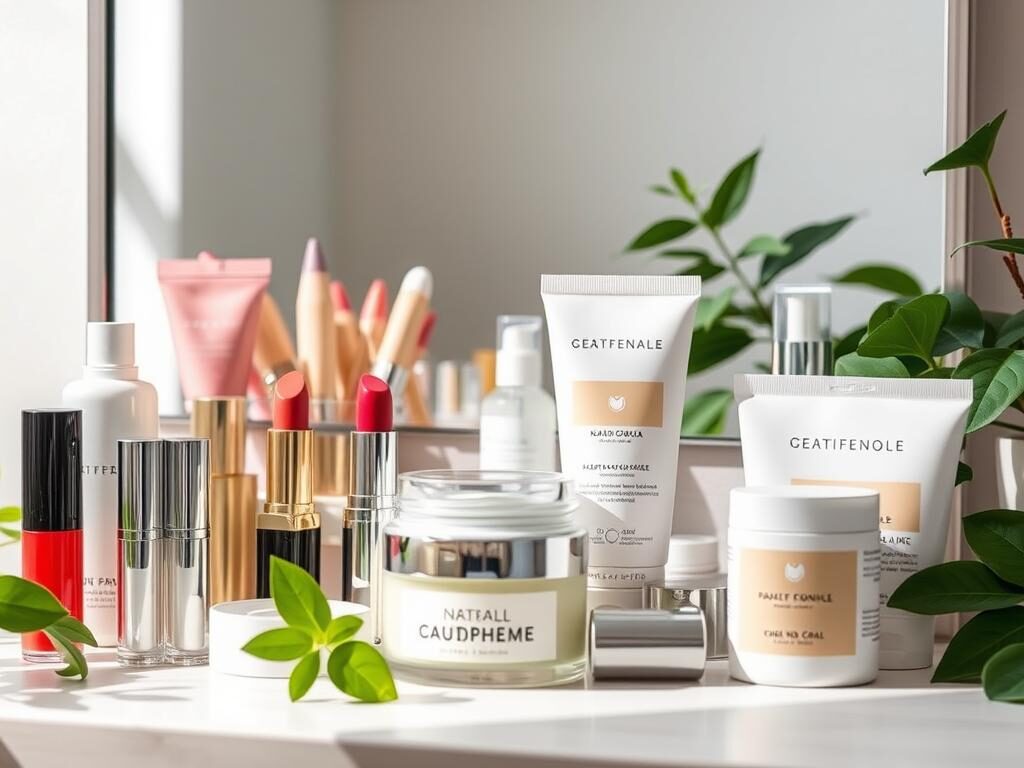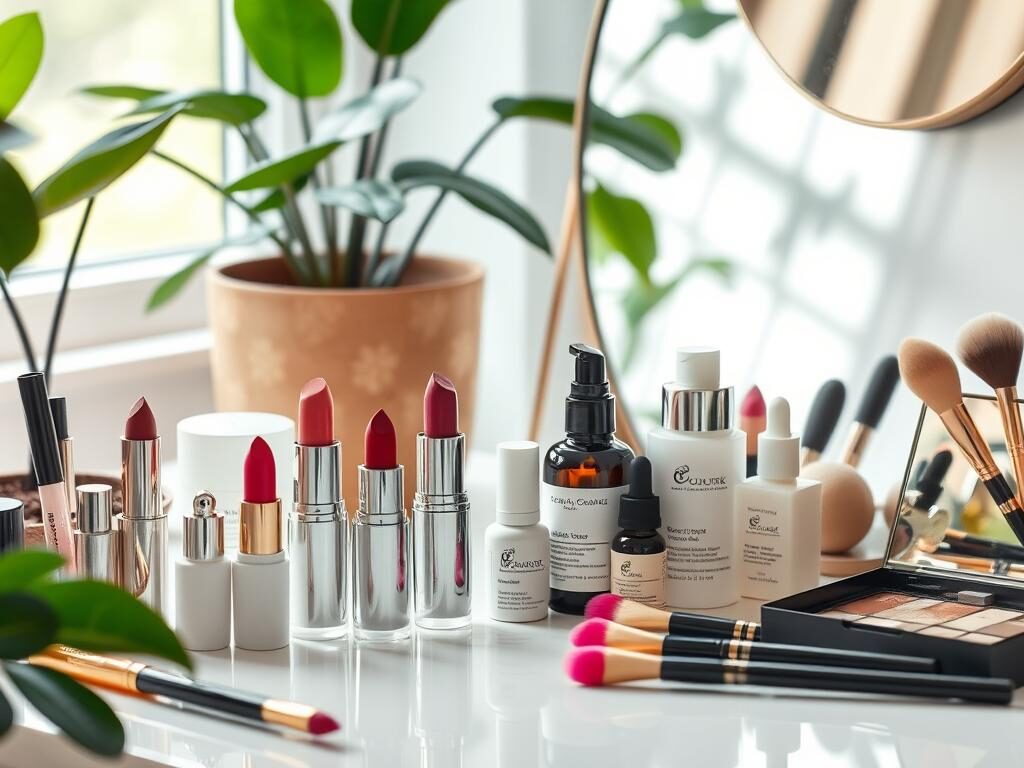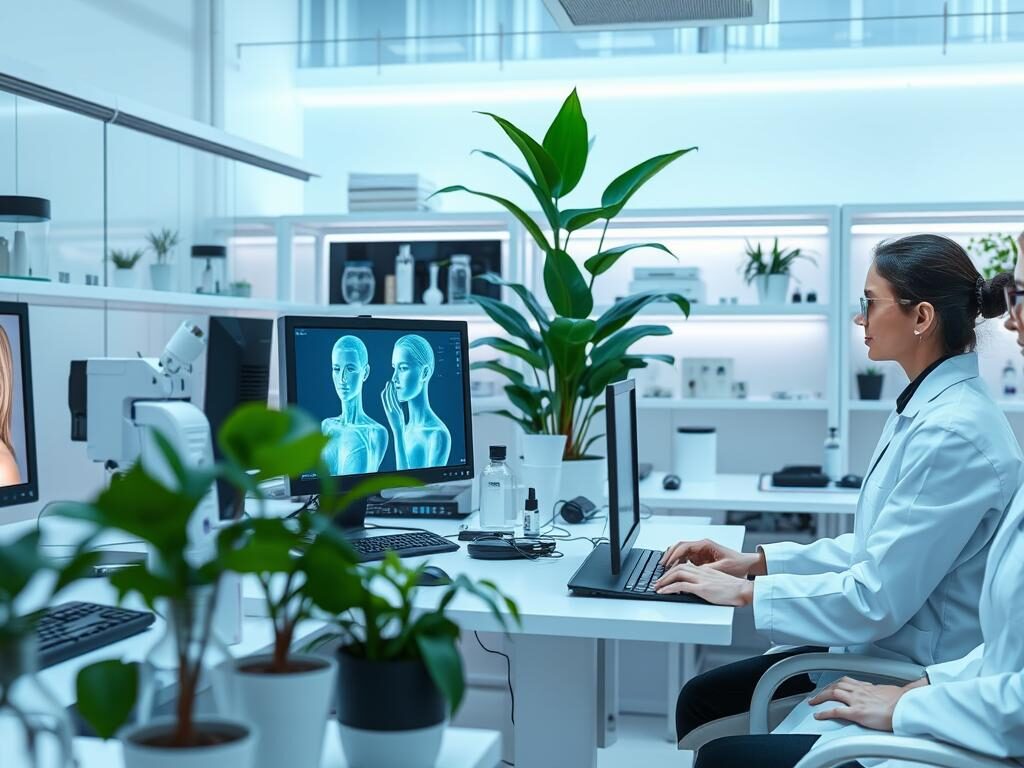Physical Address
304 North Cardinal St.
Dorchester Center, MA 02124
Physical Address
304 North Cardinal St.
Dorchester Center, MA 02124
Welcome to your guide to cruelty-free beauty. We’ll cover what “cruelty-free” means, debunk myths, and look at animal testing history. You’ll learn about global rules, why ethical beauty matters, and how to spot real cruelty-free products.
We’ll also show you the best cruelty-free beauty brands. You’ll see the difference between cruelty-free and vegan products. By the end, you’ll know how to choose ethical beauty products.

Do you know what “cruelty-free” really means in beauty products? Cruelty-free beauty items are made without animal testing at any stage. This means no animals were harmed in making these products.
There are many wrong ideas about cruelty-free labels. Some think “cruelty-free” means vegan, but that’s not true. Cruelty-free products might still have animal parts in them. Also, not all cruelty-free labels are the same, with some being stricter than others.
Animal testing in cosmetics has a long, debated history. For years, many animals were tested on in painful ways. But, as people became more aware of animal welfare, the industry started to change.
Now, many countries have rules against animal testing in cosmetics. The European Union, for example, banned animal-tested cosmetics. India and Israel also have laws against it. But, there’s still more to do to make beauty products cruelty-free worldwide.
In today’s beauty world, picking ethical beauty products is key. More people now think about how their choices affect the planet and animals. By choosing sustainable beauty brands, you help make the beauty world better for everyone and the environment.
Choosing ethical beauty helps animals too. Many old beauty companies still test on animals. But, by picking cruelty-free brands, you help stop this cruelty.
Also, ethical beauty products are better for the planet. Sustainable beauty brands use materials that are good for the earth. This is what many people want now.
Choosing ethical beauty also keeps you healthy. Old beauty products can have bad stuff in them. But, sustainable beauty brands use safer, natural ingredients.
By joining the green beauty movement, you help the beauty world get better. Your choices can change things for the better.
When you look for ethical beauty, remember you’re making a difference. Learn about sustainable beauty brands and use your money to help. We can all make the beauty world a better place together.
Finding cruelty-free beauty products can be hard. There are many certifications and seals claiming to be ethical. But not all are the same. It’s key to know which ones are trusted and why.
The Leaping Bunny certification is the top choice for cruelty-free products. It’s from the Coalition for Consumer Information on Cosmetics (CCIC). Brands must pass a tough audit and follow strict rules to get it. Leaping Bunny certified brands are safe for those who want cruelty-free beauty and personal care.
PETA, a big animal rights group, also has a cruelty-free certification. It’s not as strict as Leaping Bunny but shows a brand avoids animal testing. PETA checks a company’s policies and supply chain to make sure no animal products or testing are used.
Knowing about these trusted certifications helps people find real cruelty-free brands. This way, they can choose products that match their values.
The demand for eco-friendly beauty products is growing fast. More and more top brands are now cruelty-free and sustainable. Let’s explore some of the leading cruelty-free beauty brands of 2024:
| Brand | Cruelty-Free Certification | Vegan Options | Sustainable Packaging |
|---|---|---|---|
| Pacifica Beauty | PETA and Leaping Bunny Certified | Yes, wide range | Yes, made from recycled materials |
| Beautycounter | Leaping Bunny Certified | Yes, select products | Yes, sustainable and recyclable |
| Glossier | Cruelty-Free and PETA Certified | Yes, many vegan options | Yes, eco-friendly packaging |
These brands are at the forefront of the eco-friendly beauty movement. As people become more aware of what they buy, these brands are leading the way in ethical and sustainable beauty.
Choosing ethical beauty products can be tricky. The terms “cruelty-free” and “vegan” are often mixed up. But, it’s key to know the difference. This knowledge helps you pick the right products.
Cruelty-free products don’t test on animals. This rule applies to all stages of making the product. Vegan products, however, don’t use animal parts like beeswax or collagen.
When looking for cruelty-free and vegan products, read labels well. Look for certifications like Leaping Bunny or PETA’s Beauty Without Bunnies. For vegan products, check the ingredients for animal parts.
Knowing the difference between cruelty-free and vegan products helps you make better choices. Remember, a product can be one but not the other.
Switching to cruelty-free beauty might seem hard, but it’s a big step towards living ethically. You can change your cruelty-free skincare or try cruelty-free makeup. It’s a journey that feels good and makes you stronger.
First, check what beauty products you use. Find out which ones aren’t cruelty-free. Then, look for clean beauty products that fit your needs. Many big brands now offer cruelty-free options, making it easier to switch.
Changing to cruelty-free beauty takes time, but it’s worth it. Be patient, do your homework, and celebrate each change. It’s a journey to a more kind and responsible beauty routine.

| Product Category | Cruelty-Free Alternatives |
|---|---|
| Moisturizers | Cetaphil, CeraVe, Drunk Elephant |
| Cleansers | Glossier, Pacifica, First Aid Beauty |
| Foundations | Fenty Beauty, Ilia, bareMinerals |
| Serums | The Ordinary, Naturium, Versed |
| Mascara | Ilia, Tarte, Hourglass |
| Lipsticks | Bite Beauty, Kjaer Weis, Axiology |
As conscious consumers, we need to make smart choices with our beauty buys. Finding cruelty-free and sustainable beauty can seem hard. But, with the right tips, you can create a beauty routine that matches your values.
It’s getting easier to find cruelty-free shopping tips and sustainable beauty brands. Big stores like Sephora and Ulta now have sections for ethical products. You can also check out Etsy and specialty stores for natural and sustainable beauty.
Switching to cruelty-free beauty doesn’t have to cost a lot. Many sustainable beauty brands offer affordable choices. Look for sales or buy in bulk to save money. Also, consider multi-purpose products to replace several items in your routine.
Remember, every small step counts. By choosing cruelty-free and sustainable beauty, you help animals and the planet. You’re contributing to a better future.
The beauty industry is moving towards cruelty-free and non-toxic products. This change is driven by consumer demand and new technology. It’s a shift towards ethical and sustainable practices.
Advanced in-vitro testing methods are becoming key. These lab-based techniques, like 3D tissue engineering and organ-on-a-chip models, mimic human tissues and organs. This allows for accurate testing without animals.
Computational models and artificial intelligence (AI) are also making progress. These systems can predict the safety and efficacy of cosmetic ingredients without animal testing. They analyze large datasets and use predictive modeling.
| Innovation | Description | Advantages |
|---|---|---|
| 3D Tissue Engineering | Creating realistic, three-dimensional models of human tissues and organs | More accurate representation of how products interact with the body |
| Organ-on-a-chip | Microfluidic devices that simulate the physiological functions of organs | Enables smaller-scale testing and study of cosmetic ingredient effects |
| Computational Models and AI | Advanced algorithms that analyze data and predict the safety and efficacy of ingredients | Eliminates the need for animal testing |
The beauty industry’s future looks bright and cruelty-free. With more animal testing alternatives and demand for non-toxic beauty products, it’s heading towards a more ethical path.

Choosing ethical beauty products that are cruelty-free is a powerful way to make a positive impact. By supporting brands that care about animal welfare and the environment, you help change the beauty industry for the better.
The cruelty-free movement is not just a trend. It’s a strong commitment to a kinder, more responsible future. By staying informed, checking product labels, and making smart choices, you can lead the way in ethical beauty. You can also inspire others to join you.
The beauty industry’s future looks bright. There are new, animal-friendly alternatives and a growing need for eco-friendly, cruelty-free products. Let’s celebrate the progress we’re making. Together, we can make the beauty world better for everyone, including animals.
Cruelty-free beauty products are not tested on animals. Brands use alternative methods like in-vitro testing. This ensures their products are safe for humans without harming animals.
Look for the Leaping Bunny logo or PETA’s cruelty-free certification. These are signs that a brand has been thoroughly checked. They confirm the brand’s products and supply chain are cruelty-free.
Cruelty-free products are not tested on animals but might have animal ingredients. Vegan products, however, have no animal ingredients. So, all vegan products are cruelty-free, but not all cruelty-free products are vegan.
Replace your non-cruelty-free products with certified alternatives as they finish. Look for cruelty-free brands in skincare, makeup, and hair care. Build a cruelty-free routine that meets your needs and preferences.
Look at brands like e.l.f. Cosmetics, NYX Professional Makeup, and The Body Shop. Online retailers and direct-to-consumer brands also offer affordable cruelty-free options. Explore new brands to find affordable cruelty-free products.
Avoid ingredients like beeswax, lanolin, collagen, carmine, and animal-based glycerin. Check product labels and research ingredients to spot and avoid these non-vegan and potentially non-cruelty-free components.
The beauty industry is moving to alternative testing methods. This includes in-vitro testing, computer modeling, and human cell cultures. Global regulations are also banning or phasing out animal testing, pushing the industry towards cruelty-free solutions.